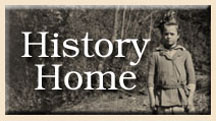

Agriculture: Page 2
In fact, the only real work involved in hog husbandry came during the late
fall, for it was at this time that mountain farmers rounded up their porcine
charges in preparation for “hog-killing.” According to historian
and former Cades Cove resident A. Randolph Shields, “hog-killing”
was often a community event, one which saw multiple families gather to slaughter
and process hogs. To begin the process, the hogs were killed with a rifle
or a sledgehammer, and then suspended by their back feet and drained of blood.
The carcasses were then boiled to loosen the hair (children, Shields notes,
were given the job of “fill[ing] the kettles with water from the spring
or creek and . . . keep[ing] the fires under them well-stoked”), scraped
clean with large knives, and then, after the organs were removed, left to
hang overnight in the bitter cold. The following day, the carcasses were carved
into hams, loins, and chops, and the “lean trimmings were processed
into sausage.” The hams and other chops were then salted, smoked, and
stored away, there to provide the family with nutritious meat during the long
winter months. Of course, the hog had other uses as well, some of which had
nothing to do with providing nutrition: fat trimmings were rendered into lard
for cooking, or mixed with wood ashes and turned into lye soap.
Important as hog and hominy were to Southern Appalachian farmers, however,
they were by no means the only source of nutrition available. Mountain families
cultivated potatoes, squash, beans, tomatoes, greens, and other garden vegetables
during the summer months; raised sheep both as a food source and as a source
of wool (although sheep were never as important as hogs as a source of protein);
raised cattle for meat and milk; raised chickens and ducks for food, eggs,
and as a source of feathers and down for use in pillows, mattresses, and warm
winter garments; gathered blueberries, blackberries, ginseng, dandelions,
wild leeks or “ramps,” and a host of other edible plants from
the fencerows and mountain forests; tended apple and peach trees; kept beehives
and processed sugarcane as a means to sweeten their food; and supplemented
their diets with a variety of game animals such as deer, bears, squirrels,
and fish. A handful of farmers also cultivated winter wheat and rye for use
in flour-making, although it was difficult to do so in the more rugged corners
of the region (such as Gatlinburg) and so was relatively rare.
All told, Southern Appalachian agriculture provided mountain families with
nutritious, if not altogether healthy meals (the mountaineers’ diet,
laden as it was with fats and starches, would make a modern nutritionist shudder).
And yet, the methods that they used were often terribly destructive to the
land, serving to diminish farmers’ prospects for raising an adequate
supply of food.
Corn, like cotton and tobacco, is a hungry plant which leaches phosphoric
acid, nitrogen, and potash from the soil. Farmers may, with careful crop rotation
and the cultivation of cover crops, curb soil depletion and preserve fertility.
But in the rugged Southern Appalachians, land scarcity led farmers to plant
corn in the same fields year after year, thereby destroying the very basis
of their livelihood. After several years of such abuse, even the most fertile
soils lost their ability to sustain food crops. Devoid of ground cover, hillside
soils gave way quickly to erosion, leaving behind a landscape of parched soil,
deep gullies, and thick tangles of broomsedge, briars, and other hardy weed
species. To make matters worse, the hogs and cattle on which Southern Appalachian
mountaineers depended for protein and milk were destructive in their own right,
devouring underbrush and root systems, trampling sapling trees, and otherwise
intensifying the effects of erosion.
The only hope of correcting these problems would have been to institute vocational
agricultural classes in the region. But the region’s schools were too
poorly funded, and the mountaineers too resistant, generally speaking, to
the notion of “book farming,” to support such programs. And so,
Southern Appalachian farmers (at least those in the more isolated corners)
continued on as they always had, scratching out a living on lands that grew
ever more marginal each and every year. If positive changes were to be made,
they would have to come from the outside.
| <<< Page 1 | Page
2 |
 |
|